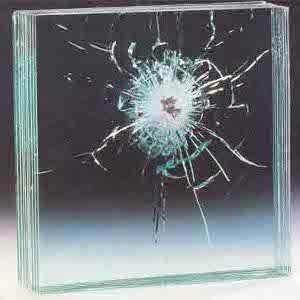Glass areas present a tempting appearance of weakness in any building security plan. Safety glass, although never perfect, can make these areas of apparent weakness stronger than many standard walls.
The goal of safety glass is not to “never” fail”, but to make failures harder to force and to fail safely when failure does occur. For example, one of the important functions of safety glass is to prevent shards of glass from becoming dangerous shrapnel when the glass eventually does fail.
Perfectly indestructible safety glass, if it is ever developed, will focus attackers attentions on defeating window frames and surrounding walls.
Safety glass should provide resistance against the following threats:

- Bullets
- Sledgehammer
- Blowtorch
- Drill
- Sabre Saw
- Explosive force
- Hurricane force winds
Bullet Resistant Glass
Underwriters Laboratories publishes specifications for various levels of bullet-resistant glass as part of UL Standard 752:
| Rating | Test Ammunition |
Nominal Bullet Mass Grain (g) |
Minimum Test Bullet Velocity Ft/s (m/s) |
Number of Shots |
|---|---|---|---|---|
| Level 1 | 9 mm FMJ with lead core | 124 (8.0) | 1175 (358) | 3 |
| Level 2 | .357 Magnum lead JSP | 158 (10.2) | 1250 (381) | 3 |
| Level 3 | .44 Magnum lead SWC/GC | 240 (15.6) | 1350 (411) | 3 |
| Level 4 | .30 caliber rifle lead core SP | 180 (11.7) | 2540 (774) | 1 |
| Level 5 | 7.62 mm rifle lead core FMJ, military ball | 150 (9.7) | 2750 (838) | 1 |
| Level 6 | 9 mm FMJ with lead core | 124 (8.0) | 1400 (427) | 5 |
| Level 7 | 5.56 mm rifle FMJ with lead core | 55 (3.56) | 3080 (939) | 5 |
| Level 8 | 7.62 mm rifle lead core FMJ, military ball | 150 (9.7) | 2750 (838) | 5 |
| Level 9 | Armor-piercing 0.30 caliber FMJ | 166 (10.8) | 2715 (828) | 1 |
| Level 10 | 0.50 caliber FMJ, military ball | 709.5 (45.9) | 2810 (856) | 1 |
| Supplementary shotgun |
12-gauge rifle lead slug | 437 (28.3) | 1585 (483) | 3 |
| 12-gauge 00 lead buckshot (12 pellets) | 650 (42) | 1200 (366) | 3 |
The DoD Minimum Antiterrorism Standards for Buildings also provides some guidance.
It’s Not Really Glass
Safety glass is currently manufactured from a wide range of materials using a variety of processes. Safety “glass” might be a glass, polycarbonate, PVB (Poly Vinylbutyral), TPU (Thermoplastic Polyurethane), Ethylene Vinyl Acetate, or acrylic material. It may then be glazed, laminated, or clad to another material to benefit from the advantages of both materials. The acrylic products are generally less expensive than the polycarbonate and laminated glass products. The non-glass products are often coated to provide additional scratch resistance.
These complex composite products are sold under names like Armormax, Cyrolon, Lexan, Makroclear, and Tuffak. Often the window-makers will attempt to hide exactly which safety glass product they use. Refuse to do business with any company which avoids sharing product names and technical specifications.
